Dexmedetomidine, an alpha2-adrenergic agonist inhibits neuronal delayed-rectifier potassium current
- 格式:pdf
- 大小:508.86 KB
- 文档页数:11
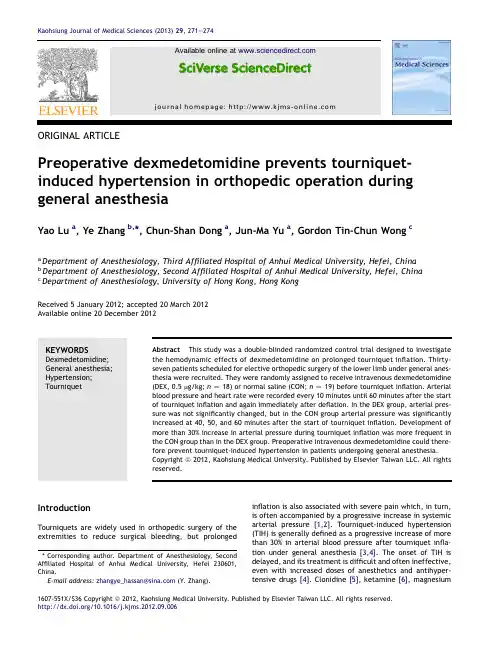
ORIGINAL ARTICLEPreoperative dexmedetomidine prevents tourniquet-induced hypertension in orthopedic operation during general anesthesiaYao Lu a ,Ye Zhang b ,*,Chun-Shan Dong a ,Jun-Ma Yu a ,Gordon Tin-Chun Wong caDepartment of Anesthesiology,Third Affiliated Hospital of Anhui Medical University,Hefei,China bDepartment of Anesthesiology,Second Affiliated Hospital of Anhui Medical University,Hefei,China cDepartment of Anesthesiology,University of Hong Kong,Hong KongReceived 5January 2012;accepted 20March 2012Available online 20December 2012KEYWORDSDexmedetomidine;General anesthesia;Hypertension;TourniquetAbstract This study was a double-blinded randomized control trial designed to investigate the hemodynamic effects of dexmedetomidine on prolonged tourniquet inflation.Thirty-seven patients scheduled for elective orthopedic surgery of the lower limb under general anes-thesia were recruited.They were randomly assigned to receive intravenous dexmedetomidine (DEX,0.5m g/kg;n Z 18)or normal saline (CON;n Z 19)before tourniquet inflation.Arterial blood pressure and heart rate were recorded every 10minutes until 60minutes after the start of tourniquet inflation and again immediately after deflation.In the DEX group,arterial pres-sure was not significantly changed,but in the CON group arterial pressure was significantly increased at 40,50,and 60minutes after the start of tourniquet inflation.Development of more than 30%increase in arterial pressure during tourniquet inflation was more frequent in the CON group than in the DEX group.Preoperative intravenous dexmedetomidine could there-fore prevent tourniquet-induced hypertension in patients undergoing general anesthesia.Copyright ª2012,Kaohsiung Medical University.Published by Elsevier Taiwan LLC.All rights reserved.IntroductionTourniquets are widely used in orthopedic surgery of the extremities to reduce surgical bleeding,but prolongedinflation is also associated with severe pain which,in turn,is often accompanied by a progressive increase in systemic arterial pressure [1,2].Tourniquet-induced hypertension (TIH)is generally defined as a progressive increase of more than 30%in arterial blood pressure after tourniquet infla-tion under general anesthesia [3,4].The onset of TIH is delayed,and its treatment is difficult and often ineffective,even with increased doses of anesthetics and antihyper-tensive drugs [4].Clonidine [5],ketamine [6],magnesium*Corresponding author.Department of Anesthesiology,Second Affiliated Hospital of Anhui Medical University,Hefei 230601,China.E-mail address:zhangye_hassan@ (Y.Zhang).1607-551X/$36Copyright ª2012,Kaohsiung Medical University.Published by Elsevier Taiwan LLC.All rights reserved./10.1016/j.kjms.2012.09.006Available online atjournal homepage:Kaohsiung Journal of Medical Sciences (2013)29,271e 274[7],and stellate ganglion block[8]have been used prophylactically to prevent TIH.Although the mechanism of TIH is unknown,the autonomic nervous system is involved [1].Dexmedetomidine is a potent a2-adrenoceptor agonist with eight times higher affinity for the a2-adrenoceptor than clonidine,and it has shown sedative,analgesic,and anxiolytic effects after intravenous administration[9].Dexmedetomi-dine attenuates hyperadrenergic responses and therefore may be of therapeutic or prophylactic value for TIH.In this study,we investigated the effect of preoperative intravenous dexmedetomidine on arterial blood pressure and heart rate in patients undergoing general anesthesia for orthopedic surgery of the lower limbs with a tourniquet. MethodsThis study was randomized,double-blinded,and placebo-controlled.After approval was obtained from the ethics committee of the Third Affiliated Hospital of Anhui Medical University and written informed consent was received from each patient,37ASA(American Society of Anesthesiologists) physical status class I and II patients scheduled for ortho-pedic operation requiring tourniquet inflation of the lower limbs under general anesthesia were enrolled.Patients with known contraindications to dexmedetomidine;who had ischemic heart disease,hypertension,kidney dysfunction,or diabetes mellitus;and with expected tourniquet inflation time shorter than60minutes were excluded.All patients received intramuscular phenobarbital (0.5mg)30minutes before induction of anesthesia. Patients in the dexmedetomidine group(DEX;n Z18) received intravenous dexmedetomidine(0.5m g/kg)diluted in10mL normal saline infused over10minutes,immedi-ately before induction of anesthesia.Patients in the control group(CON;n Z19)received the same volume of normal saline infused over the same period.The infusions were prepared by a nurse anesthetist not involved with the case according to a computer-generated sequence.Anesthesia was induced with fentanyl(2e4m g/kg)and propofol(2mg/ kg),and vecuronium(0.1mg/kg)was given intravenously to facilitate intubation of the trachea.Arterial pressure before induction of anesthesia was measured noninvasively. After anesthesia induction,a radial artery catheter was inserted for invasive blood pressure measurements.Anes-thesia was maintained with propofol(75m g/kg/min)and remifentanil(0.1m g/kg/min).Muscle paralysis was main-tained with vecuronium.Tidal volume was adjusted to keep the end-tidal CO2concentration35e45mmHg.After skin incision,the tourniquet was inflated to a pressure of 300mmHg.If systolic arterial pressure exceeded180mmHg despite increased doses of propofol and remifentanil,an additional bolus of nitroglycerol was given intravenously.Blood pressure and heart rate were recorded at0,10, 20,30,40,50,and60minutes after the start of tourniquet inflation and immediately after tourniquet deflation.The number of patients who developed TIH,as defined by an increase in arterial blood pressure greater than30%of the baseline value,was recorded.The patients were extubated at the end of surgery after reversal with atropine(0.5mg) and neostigmine(1mg).Statistical analysis was performed using the SPSS10.0 program(SPSS Inc.,Chicago,IL,USA).All data are presented as meanÆstandard deviation.Demographic data for the patients were compared among the groups using one-way analysis of variance with the post hoc Scheffe´test.The hemodynamic changes were compared with the baseline values and among the groups by using two-way repeated-measures analysis of variance with Tukey’s post hoc test.The c2test was used to compare the number of patients with TIH. Statistical differences were considered significant if the p value was less than0.05.ResultsThere were no statistically significant differences between the groups with respect to the patients’demographic characteristics,dose of propofol and remifentanil,time for duration of tourniquet inflation,and anesthesia(Table1).In the DEX group,systolic and diastolic arterial pressures were not changed during the study period,but in the CON group,systolic arterial pressure and diastolic arterial pressure were significantly increased at40,50,and60 minutes after the start of tourniquet inflation.In all patients,the heart rate did not change significantly during tourniquet inflation,but there was a significant increase immediately after deflation in the CON group(Fig.1).The CON group had a greater percentage of patients who developed TIH when compared with the DEX group. DiscussionThe results from this study showed that preoperative intravenous dexmedetomidine significantly prevented a systemic arterial pressure increase during prolonged tourniquet inflation in patients under general anesthesia.Perioperative hypertension may be associated with serious cardiac complications[10e12].Furthermore,the level of hypertension is correlated with the occurrence of postoperative silent myocardial ischemia[12].The intra-operative hypertension induced by prolonged tourniquet inflation of the lower limbs is often unresponsive to increased doses of anesthetics and antihypertensive drugs272Y.Lu et al.[4].Once tourniquet-induced arterial pressure increase develops,it is often difficult to control.In these patients,intravenous dexmedetomidine before tourniquet inflation may have a role in attenuating these blood pressure increases.Tetzlaff et al.[1]showed that tourniquet-induced arterial pressure increases correlate with the activation of the sympathetic nervous system,as measured by power spectral heart rate analysis.An increase in plasma norepinephrine levels was related to the tourniquet-induced arterial pressure increase under general anes-thesia [13].Catecholamine release after the activation of the sympathetic nervous system may contribute to the increase in systemic arterial pressure during prolonged tourniquet inflation.Dexmedetomidine is an a 2-receptor agonist with both sedative and analgesic properties that reduce the sedation,anxiolytic,and analgesic require-ments in the perioperative setting [9].Dexmedetomidine improves hemodynamic stability in the perioperative period by exerting sympatholytic effects via activation of the inhibitory a 2-receptors both in the central nervous system and on peripheral sympathetic nerve endings [14,15],and reduces plasma epinephrine and norepinephrine levels [16,17].Dexmedetomidine has been reported to be useful in attenuating hemodynamic stress secondary to hyper-adrenergic over-reactivity [18].In awake patients,the addition of dexmedetomidine to the local anesthetic solution in intravenous regional anes-thesia decreases tourniquet pain [19].Preoperative intra-venous clonidine blunts both the increase in sympathetic out flow and arterial hypertension associated with tourni-quet inflation under general anesthesia [5].In this study,we have shown that preoperative intravenous dexmedeto-midine could also prevent TIH.The use of dexmedetomi-dine may have added benefits such as attenuating the cardiovascular and sympathoadrenal response to intubation and extubation [20]and reducing opioid requirements during and after surgery [20,21].Dexmedetomidine decreases the incidence and frequency of delirium in chil-dren [22]and adults [23].There are several limitations in this study.First,we did not perform a dose e response study having only used one dose.Future studies could evaluate whether smaller doses can achieve the same benefit or whether larger doses can reduce TIH to a greater extent.Second,the effect of dexmedetomidine on the relationship between tourniquet-induced pain and hypertension was not evaluated,because this study was performed in patients receiving general stly,the depth of anesthesia might have been different in the two groups as we did not use any depth of anesthesia monitoring However,there were no significant differences in propofol and remifentanil consumption during the study period and arterial pressure before tour-niquet inflation between the groups.In conclusion,preoperative intravenous dexmedetomi-dine significantly prevents hemodynamic responses to pro-longed tourniquet inflation of the lower limbs under general anesthesia in patients.On the basis of the results of this study,further investigations are needed to show whether perioperative outcome in patients with arterial hyperten-sion or cardiovascular disease is improved by dexmedeto-midine treatment.References[1]Tetzlaff JE,O’Hara J,Yoon HJ,Schubert A.Tourniquet-induced hypertension correlates with autonomic nervous system changes detected by power spectral heart rate anal-ysis.J Clin Anesth 1997;9:138e 42.[2]Hagenouw RR,Bridenbaugh PO,van Egmond J,Stuebing R.Tourniquet pain:a volunteer study.Anesth Analg 1986;65:1175e80.Figure 1.Hemodynamic changes in the two groups.Values are presented as mean ÆSD.After Z immediately after tourniquet deflation;Baseline Z immediately before anes-thesia induction;Before Z after anesthesia induction and immediately before tourniquet inflation;CON Z group receiving normal saline;DBP Z diastolic blood pressure;DEX Z dexmedetomidine;HR Z heart rate;SBP Z systolic blood pressure.Dexmedetomidine prevents hypertension 273[3]Valli H,Rosenberg PH,Kytta J,Nurminen M.Arterial hyper-tension associated with the use of a tourniquet with either general or regional anaesthesia.Acta Anaesthesiol Scand 1987;31:279e83.[4]Valli H,Rosenberg PH.Effects of three anaesthesia methodson haemodynamic responses connected with the use of thigh tourniquet in orthopaedic patients.Acta Anaesthesiol Scand 1985;29:142e7.[5]Zalunardo MP,Serafino D,Szelloe P,Weisser F,Zollinger A,Seifert B,et al.Preoperative clonidine blunts hyperadrenergic and hyperdynamic responses to prolonged tourniquet pressure during general anesthesia.Anesth Analg2002;94:615e8. [6]Satsumae T,Yamaguchi H,Sakaguchi M,Yasunaga T,Yamashita S,Yamamoto S,et al.Preoperative small-dose ketamine prevented tourniquet-induced arterial pressure increase in orthopedic patients under general anesthesia.Anesth Analg2001;92:1286e9.[7]Lee DH,Jee DL,Kim SY,Kim JM,Lee HM.Magnesium sulphateattenuates tourniquet-induced hypertension and spinal c-fos mRNA expression:a comparison with ketamine.J Int Med Res 2006;34:573e84.[8]Arai YC,Ogata J,Matsumoto Y,Yonemura H,Kido K,Uchida T,et al.Preoperative stellate ganglion blockade prevents tourniquet-induced hypertension during general anesthesia.Acta Anaesthesiol Scand2004;48:613e8.[9]Bhana N,Goa KL,McClellan KJ.Dexmedetomidine.Drugs2000;59:263e8.[10]Seltzer JL,Gerson JI,Grogono AW.Hypertension in peri-operative period.N Y State J Med1980;80:29e31.[11]Howell SJ,Hemming AE,Allman KG,Glover L,Sear JW,Foex P.Predictors of postoperative myocardial ischaemia.The role of intercurrent arterial hypertension and other cardiovascular risk factors.Anaesthesia1997;52:107e11.[12]Forrest JB,Rehder K,Cahalan MK,Goldsmith CH.Multicenterstudy of general anesthesia:III.Predictors of severe peri-operative adverse outcomes.Anesthesiology1992;76:3e15.[13]Crews JC,Sehlhorst CS.Response to maintenance of tourni-quet inflation in a primate model.Reg Anesth1991;16:195e8.[14]Schmelling W,Farber N.The effects of alpha-2adrenergicagonists on cardiovascular system.Semin Cardiothor Vasc Anesth1997;1:1e20.[15]Lawrence C,DeLange S.Effects of a single pre-operativedexmedetomidine dose on isoflurane requirements and peri-operative haemodynamic stability.Anaesthesia1997;52: 736e44.[16]Ebert TJ,Hall JE,Barney JA,Uhrich TD,Colinco MD.Theeffects of increasing plasma concentrations of dexmedeto-midine in humans.Anesthesiology2000;93:382e94.[17]Talke P,Chen R,Thomas B,Aggarwall A,Gottlieb A,Thorberg P,et al.The hemodynamic and adrenergic effects of perioperative dexmedetomidine infusion after vascular surgery.Anesth Analg2000;90:834e9.[18]Kulkarni A,Price G,Saxena M,Skowronski G.Difficult extu-bation:calming the sympathetic storm.Anaesth Intensive Care2004;32:413e6.[19]Ramadhyani U,Park JL,Carollo DS,Waterman RS,Nossaman BD.Dexmedetomidine:clinical application as an adjunct for intravenous regional anesthesia.Anesthesiol Clin 2010;28:709e22.[20]Scheinin B,Lindgren L,Randell T,Scheinin H,Scheinin M.Dexmedetomidine attenuates sympathoadrenal responses to tracheal intubation and reduces the need for thiopentone and peroperative fentanyl.Br J Anesthesia1992;68:126e31. [21]Lin TF,Yeh YC,Lin FS,Wang YP,Lin CJ,Sun WZ,et al.Effect ofcombining dexmedetomidine and morphine for intravenous patient-controlled analgesia.Br J Anesthesia2009;102:117e22.[22]Shukry M,Clyde MC,Kalarickal PL,Ramadhyani U.Does dex-medetomidine prevent emergence delirium in children after sevoflurane-based general anesthesia?Pediatr Anaesth2005;15:1098e104.[23]Shehabi Y,Grant P,Wolfenden H,Hammond N,Bass F,Campbell M,et al.Prevalence of delirium with dexmedeto-midine compared with morphine based therapy after cardiac surgery:a randomized controlled trial(DEXmedetomidine COmpared to Morphine-DEXCOM Study).Br J Anesthesia2009;111:1075e84.274Y.Lu et al.。
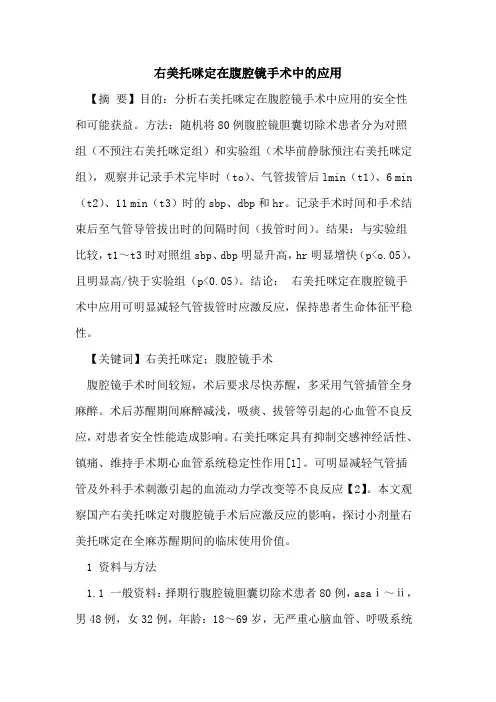
右美托咪定在腹腔镜手术中的应用【摘要】目的:分析右美托咪定在腹腔镜手术中应用的安全性和可能获益。
方法:随机将80例腹腔镜胆囊切除术患者分为对照组(不预注右美托咪定组)和实验组(术毕前静脉预注右美托咪定组),观察并记录手术完毕时(to)、气管拔管后lmin(t1)、6 min (t2)、11 min(t3)时的sbp、dbp和hr。
记录手术时间和手术结束后至气管导管拔出时的间隔时间(拔管时间)。
结果:与实验组比较,t1~t3时对照组sbp、dbp明显升高,hr明显增快(p<o.05),且明显高/快于实验组(p<0.05)。
结论:右美托咪定在腹腔镜手术中应用可明显减轻气管拔管时应激反应,保持患者生命体征平稳性。
【关键词】右美托咪定;腹腔镜手术腹腔镜手术时间较短,术后要求尽快苏醒,多采用气管插管全身麻醉。
术后苏醒期间麻醉减浅,吸痰、拔管等引起的心血管不良反应,对患者安全性能造成影响。
右美托咪定具有抑制交感神经活性、镇痛、维持手术期心血管系统稳定性作用[1]。
可明显减轻气管插管及外科手术刺激引起的血流动力学改变等不良反应【2】。
本文观察国产右美托咪定对腹腔镜手术后应激反应的影响,探讨小剂量右美托咪定在全麻苏醒期间的临床使用价值。
1 资料与方法1.1 一般资料:择期行腹腔镜胆囊切除术患者80例,asaⅰ~ⅱ,男48例,女32例,年龄:18~69岁,无严重心脑血管、呼吸系统疾病;无糖尿病、长期服用镇静药、精神神经病病史。
随机均分为实验组(术毕前静脉预注右美托咪定组d组)和对照组(生理盐水组c组)。
1.2 方法:麻醉前肌注阿托品0.5 mg、苯巴比妥钠0.1g。
入室后经上肢静脉滴注复方氯化钠10ml/kg/h。
采用多功能监测仪检测sbp、dbp、hr。
麻醉诱导采用咪达唑仑0.03 mg/kg、芬太尼2~3μg/kg、丙泊酚1.5~2.0 mg/kg、阿曲库铵0.5~1 mg/kg静注,3min后行气管插管,机械通气,麻醉维持采用静脉输注丙泊酚4~8 mg/kg/h、瑞芬太尼15~30μg/kg/h,必要时间断吸人七氟醚。
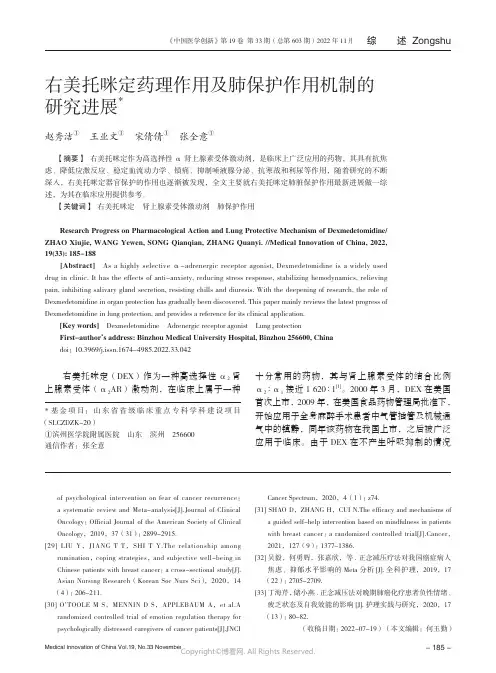
of psychological intervention on fear of cancer recurrence:a systematic review and Meta-analysis[J].Journal of Clinical Oncology:Official Journal of the American Society of Clinical Oncology,2019,37(31):2899-2915.[29] LIU Y,JIANG T T,SHI T Y.The relationship amongrumination, coping strategies, and subjective well-being in Chinese patients with breast cancer:a cross-sectional study[J].Asian Nursing Research(Korean Soc Nurs Sci),2020,14(4):206-211.[30] O ’TOOLE M S,MENNIN D S,APPLEBAUM A,et al.Arandomized controlled trial of emotion regulation therapy for psychologically distressed caregivers of cancer patients[J].JNCICancer Spectrum,2020,4(1):z74.[31] SHAO D,ZHANG H,CUI N.The efficacy and mechanisms ofa guided self-help intervention based on mindfulness in patients with breast cancer:a randomized controlled trial[J].Cancer,2021,127(9):1377-1386.[32]吴毅,何勇辉,张嘉欣,等.正念减压疗法对我国癌症病人焦虑、抑郁水平影响的Meta 分析[J].全科护理,2019,17(22):2705-2709.[33]丁海芹,储小燕.正念减压法对晚期肺癌化疗患者负性情绪、疲乏状态及自我效能的影响[J].护理实践与研究,2020,17(13):80-82.(收稿日期:2022-07-19) (本文编辑:何玉勤)*基金项目:山东省省级临床重点专科学科建设项目(SLCZDZK-20)①滨州医学院附属医院 山东 滨州 256600通信作者:张全意右美托咪定药理作用及肺保护作用机制的研究进展*赵秀洁① 王业文① 宋倩倩① 张全意① 【摘要】 右美托咪定作为高选择性α肾上腺素受体激动剂,是临床上广泛应用的药物,其具有抗焦虑、降低应激反应、稳定血流动力学、镇痛、抑制唾液腺分泌、抗寒战和利尿等作用,随着研究的不断深入,右美托咪定器官保护的作用也逐渐被发现,全文主要就右美托咪定肺脏保护作用最新进展做一综述,为其在临床应用提供参考。
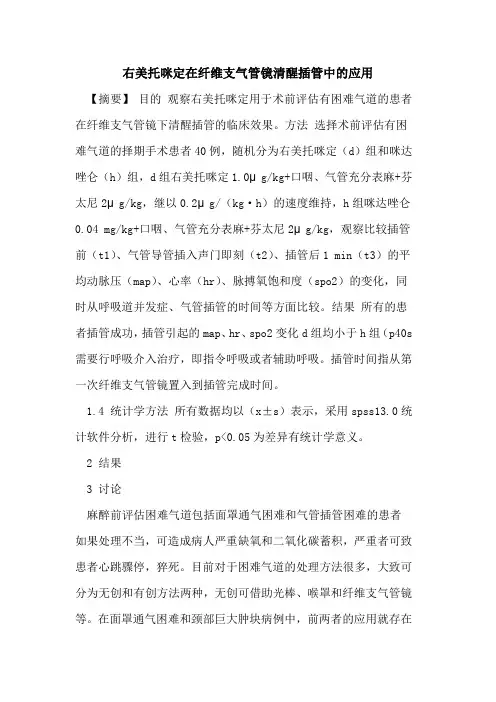
右美托咪定在纤维支气管镜清醒插管中的应用【摘要】目的观察右美托咪定用于术前评估有困难气道的患者在纤维支气管镜下清醒插管的临床效果。
方法选择术前评估有困难气道的择期手术患者40例,随机分为右美托咪定(d)组和咪达唑仑(h)组,d组右美托咪定1.0μg/kg+口咽、气管充分表麻+芬太尼2μg/kg,继以0.2μg/(kg·h)的速度维持,h组咪达唑仑0.04 mg/kg+口咽、气管充分表麻+芬太尼2μg/kg,观察比较插管前(t1)、气管导管插入声门即刻(t2)、插管后1 min(t3)的平均动脉压(map)、心率(hr)、脉搏氧饱和度(spo2)的变化,同时从呼吸道并发症、气管插管的时间等方面比较。
结果所有的患者插管成功,插管引起的map、hr、spo2变化d组均小于h组(p40s 需要行呼吸介入治疗,即指令呼吸或者辅助呼吸。
插管时间指从第一次纤维支气管镜置入到插管完成时间。
1.4 统计学方法所有数据均以(x±s)表示,采用spss13.0统计软件分析,进行t检验,p<0.05为差异有统计学意义。
2 结果3 讨论麻醉前评估困难气道包括面罩通气困难和气管插管困难的患者如果处理不当,可造成病人严重缺氧和二氧化碳蓄积,严重者可致患者心跳骤停,猝死。
目前对于困难气道的处理方法很多,大致可分为无创和有创方法两种,无创可借助光棒、喉罩和纤维支气管镜等。
在面罩通气困难和颈部巨大肿块病例中,前两者的应用就存在不足,选择保留自主呼吸,在纤支镜下行清醒气管插管就比较安全可靠[3]。
用药物如咪达唑仑、丙泊酚、瑞芬太尼行清醒气管插管,可创造较好的插管条件,但呼吸抑制率高[4]。
解决问题的焦点在于寻找一种能达到满足插管时所需的满意镇静程度且不抑制呼吸、循环的诱导方法。
右美托咪定是一种高选择性的α2受体激动剂,α2肾上腺素能受体广泛存在于中枢神经系统,外周神经和自主神经节中,主要机制为激活蓝斑核突触后膜α2肾上腺素能受体,并通过激活内源性促进睡眠途径诱导镇静,产生合作镇静和自然睡眠,并具可唤醒性,且达到这种镇静镇痛时并不引起呼吸抑制,可产生良好的镇静和遗忘效应,可作为清醒气管插管的核心用药[5]。
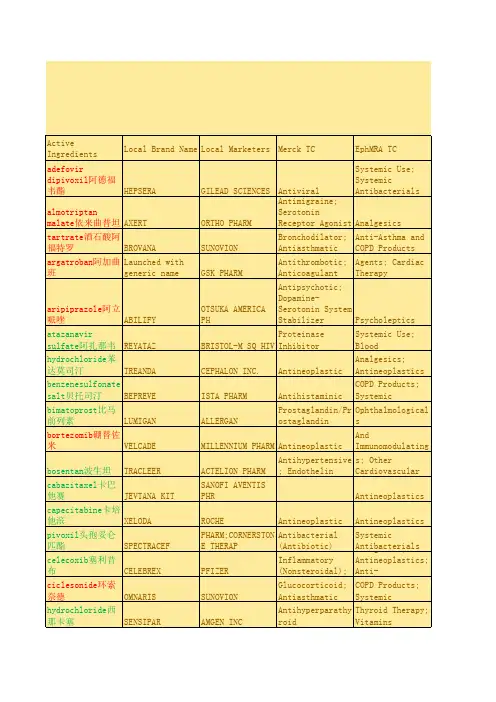
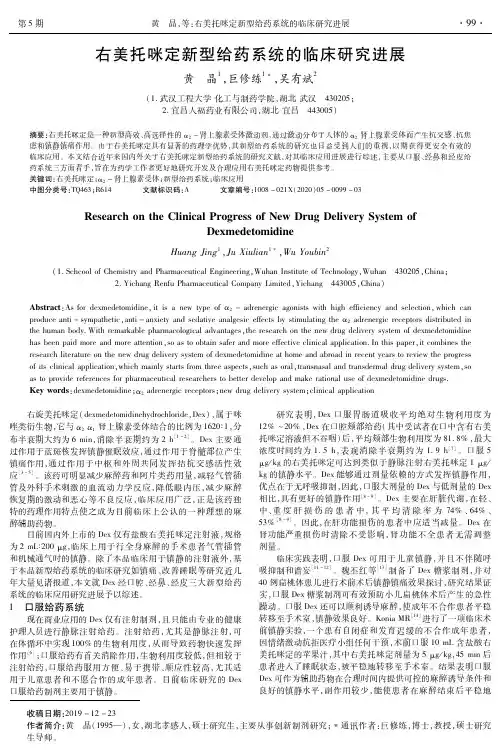
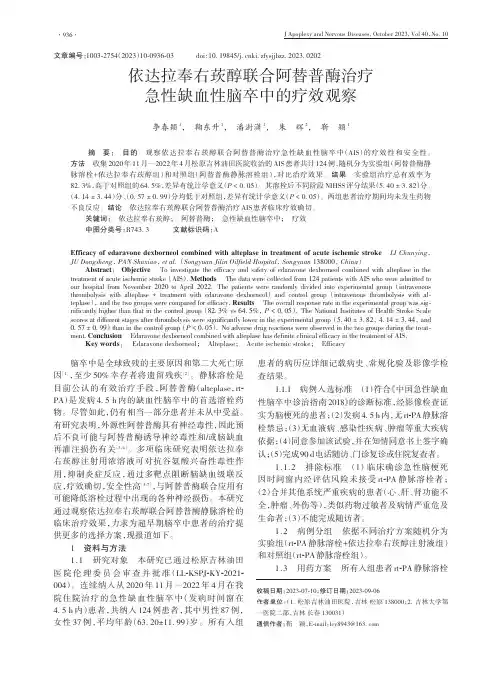
J Apoplexy and Nervous Diseases, October 2023, Vol 40,No. 10依达拉奉右莰醇联合阿替普酶治疗急性缺血性脑卒中的疗效观察李春颖1, 鞠东升1, 潘澍潇1, 朱辉2, 靳颖1摘要: 目的 观察依达拉奉右莰醇联合阿替普酶治疗急性缺血性脑卒中(AIS )的疗效性和安全性。
方法 收集2020年11月―2022年4月松原吉林油田医院收治的AIS 患者共计124例,随机分为实验组(阿替普酶静脉溶栓+依达拉奉右莰醇组)和对照组(阿替普酶静脉溶栓组),对比治疗效果。
结果 实验组治疗总有效率为82.3%,高于对照组的64.5%,差异有统计学意义(P < 0.05)。
其溶栓后不同阶段NIHSS 评分结果(5.40 ± 3.82)分、(4.14 ± 3.44)分、(0.57 ± 0.99)分均低于对照组,差异有统计学意义(P < 0.05)。
两组患者治疗期间均未发生药物不良反应。
结论 依达拉奉右莰醇联合阿替普酶治疗AIS 患者临床疗效确切。
关键词: 依达拉奉右莰醇; 阿替普酶; 急性缺血性脑卒中; 疗效中图分类号:R743.3 文献标识码:AEfficacy of edaravone dexborneol combined with alteplase in treatment of acute ischemic stroke LI Chunying ,JU Dongsheng , PAN Shuxiao , et al. (Songyuan Jilin Oilfield Hospital , Songyuan 138000, China )Abstract : Objective To investigate the efficacy and safety of edaravone dexborneol combined with alteplase in the treatment of acute ischemic stroke (AIS ).Methods The data were collected from 124 patients with AIS who were admitted to our hospital from November 2020 to April 2022. The patients were randomly divided into experimental group (intravenous thrombolysis with alteplase + treatment with edaravone dexborneol ) and control group (intravenous thrombolysis with al‑teplase ), and the two groups were compared for efficacy.Results The overall response rate in the experimental group was sig‑nificantly higher than that in the control group (82.3% vs 64.5%, P < 0.05). The National Institutes of Health Stroke Scale scores at different stages after thrombolysis were significantly lower in the experimental group (5.40 ± 3.82, 4.14 ± 3.44, and 0.57 ± 0.99) than in the control group (P < 0.05). No adverse drug reactions were observed in the two groups during the treat‑ment.Conclusion Edaravone dexborneol combined with alteplase has definite clinical efficacy in the treatment of AIS.Key words : Edaravone dexborneol ; Alteplase ; Acute ischemic stroke ; Efficacy 脑卒中是全球致残的主要原因和第二大死亡原因[1],至少50%幸存者将遗留残疾[2]。
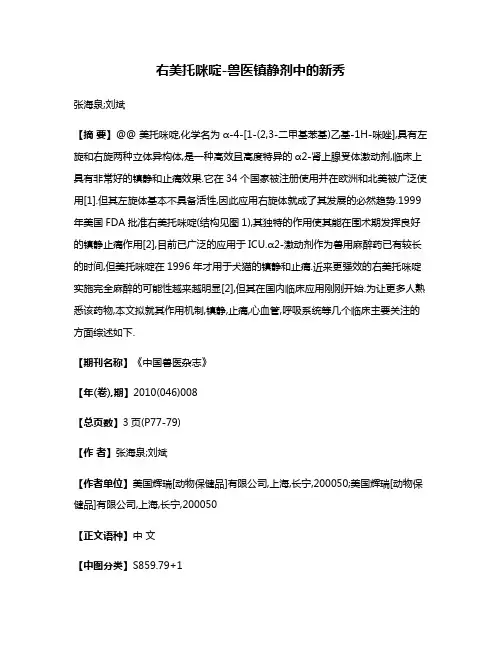
右美托咪啶-兽医镇静剂中的新秀张海泉;刘斌【摘要】@@ 美托咪啶,化学名为α-4-[1-(2,3-二甲基苯基)乙基-1H-咪唑],具有左旋和右旋两种立体异构体,是一种高效且高度特异的α2-肾上腺受体激动剂,临床上具有非常好的镇静和止痛效果.它在34个国家被注册使用并在欧洲和北美被广泛使用[1].但其左旋体基本不具备活性,因此应用右旋体就成了其发展的必然趋势.1999年美国FDA批准右美托咪啶(结构见图1),其独特的作用使其能在围术期发挥良好的镇静止痛作用[2],目前已广泛的应用于ICU.α2-激动剂作为兽用麻醉药已有较长的时间,但美托咪啶在1996年才用于犬猫的镇静和止痛.近来更强效的右美托咪啶实施完全麻醉的可能性越来越明显[2],但其在国内临床应用刚刚开始.为让更多人熟悉该药物,本文拟就其作用机制,镇静,止痛,心血管,呼吸系统等几个临床主要关注的方面综述如下.【期刊名称】《中国兽医杂志》【年(卷),期】2010(046)008【总页数】3页(P77-79)【作者】张海泉;刘斌【作者单位】美国辉瑞[动物保健品]有限公司,上海,长宁,200050;美国辉瑞[动物保健品]有限公司,上海,长宁,200050【正文语种】中文【中图分类】S859.79+1美托咪啶,化学名为α-4-[1-(2,3-二甲基苯基)乙基-1H-咪唑],具有左旋和右旋两种立体异构体,是一种高效且高度特异的α2-肾上腺受体激动剂,临床上具有非常好的镇静和止痛效果。
它在34个国家被注册使用并在欧洲和北美被广泛使用[1]。
但其左旋体基本不具备活性,因此应用右旋体就成了其发展的必然趋势。
1999年美国FDA批准右美托咪啶(结构见图1),其独特的作用使其能在围术期发挥良好的镇静止痛作用[2],目前已广泛的应用于ICU。
α2-激动剂作为兽用麻醉药已有较长的时间,但美托咪啶在1996年才用于犬猫的镇静和止痛。
近来更强效的右美托咪啶实施完全麻醉的可能性越来越明显[2],但其在国内临床应用刚刚开始。
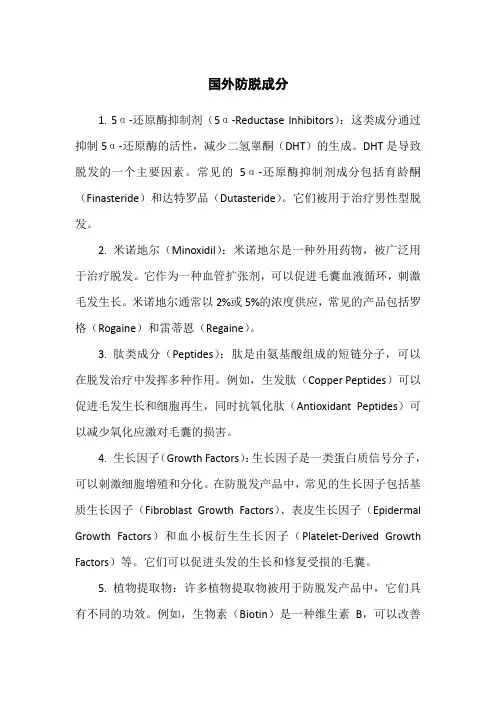
国外防脱成分1. 5α-还原酶抑制剂(5α-Reductase Inhibitors):这类成分通过抑制5α-还原酶的活性,减少二氢睾酮(DHT)的生成。
DHT是导致脱发的一个主要因素。
常见的5α-还原酶抑制剂成分包括育龄酮(Finasteride)和达特罗品(Dutasteride)。
它们被用于治疗男性型脱发。
2. 米诺地尔(Minoxidil):米诺地尔是一种外用药物,被广泛用于治疗脱发。
它作为一种血管扩张剂,可以促进毛囊血液循环,刺激毛发生长。
米诺地尔通常以2%或5%的浓度供应,常见的产品包括罗格(Rogaine)和雷蒂恩(Regaine)。
3. 肽类成分(Peptides):肽是由氨基酸组成的短链分子,可以在脱发治疗中发挥多种作用。
例如,生发肽(Copper Peptides)可以促进毛发生长和细胞再生,同时抗氧化肽(Antioxidant Peptides)可以减少氧化应激对毛囊的损害。
4. 生长因子(Growth Factors):生长因子是一类蛋白质信号分子,可以刺激细胞增殖和分化。
在防脱发产品中,常见的生长因子包括基质生长因子(Fibroblast Growth Factors)、表皮生长因子(Epidermal Growth Factors)和血小板衍生生长因子(Platelet-Derived Growth Factors)等。
它们可以促进头发的生长和修复受损的毛囊。
5. 植物提取物:许多植物提取物被用于防脱发产品中,它们具有不同的功效。
例如,生物素(Biotin)是一种维生素B,可以改善头发的强度和弹性。
薄荷脑(Menthol)可以刺激头皮,促进血液循环。
植物提取物如大豆胶原蛋白(Soy Protein)、人参(Ginseng)、迷迭香(Rosemary)等也被认为对头发生长和健康有益。
6. 抗氧化剂:抗氧化剂可以帮助减少自由基的损害,保护毛囊免受氧化应激的影响。
常见的抗氧化剂成分包括维生素E(Vitamin E)、维生素C(Vitamin C)、绿茶提取物(Green Tea Extract)和茶多酚(Polyphenols)等。
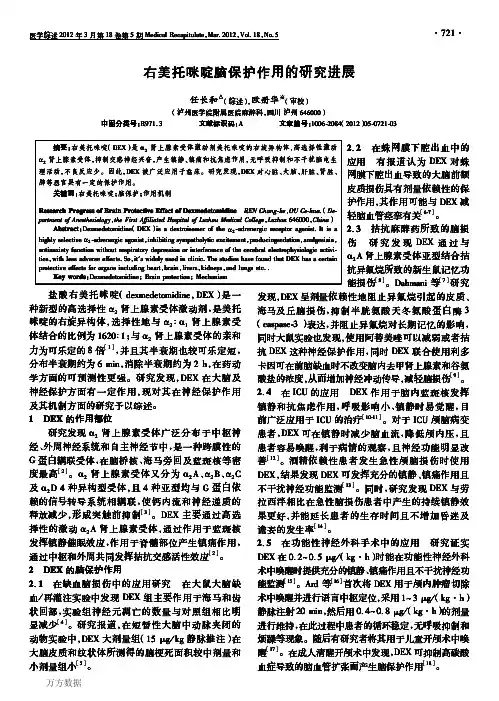
任研究发现在右美托咪陡脑保护作用的研究进展长和△(综述),欧册华※(审校)(洲州医学院附属医院麻醉科,四 洲州646000)中日分类号:R971.3 文献标识码:A 文童编号:1006⁃2084(2012)05⁃0721⁃03 摘要:右美托咪嚏(DEX )是α2肾上腺素受体激动剂美托咪嚏的右旋异构体,高选择性激动α2肾上腺素受体,抑制交感神经兴奋,产生镇静、镇痛和抗焦虑作用,无呼吸抑制和不于扰脑电生理活动,不良反应少。
因此,DEX 被广泛应用于临床。
研究发现,DEX 对心脏、大脑、肝脏、肾脏、肺等器官具有一定的保护作用。
关键词:右美托咪嚏;脑保护;作用机制Research Progress of Brain Protective Effect of Dexmedetomidine REN Chang⁃he ,OU Ce⁃hua.(De⁃partment of Anesthesiology ,the First Affiliated Hospital of Luzhou Medical College ,Luzhou 646000,China )Abstract :Dexmedetomidine (DEX )is a dextroisomer of the α2⁃adrenergic receptor agonist.It is a highly selective α2⁃adrenergic agonist ,inhibiting sympatholytic excitement ,producingsedation ,analgesiaia ,antianxiety function without respiratory depression or interference of the cerebral electrophysiologic activi⁃ties ,with less adverse effects.So ,it′s widely used in clinic.The studies have found that DEX has a certain protective effects for organs including heart ,brain ,livers ,kidneys ,and lungs etc..Key words :Dexmedetomidine ;Brain protection ;Mechanism 盐酸右美托咪陡(dexmedetomidine ,DEX )是一种韶型的高选择性α2肾k腺素受体激动剂,是美托咪陡的右旋异构体,选择性地与α2∶α1肾k腺素受体结合的比例为1620∶1;与α2肾k腺素受体的亲和力为可乐定的8倍[1],并巨其半衰期也较可乐定短,分布半衰期约为6min ,消除半衰期约为2h ,在药动学方面的可预测性更强。
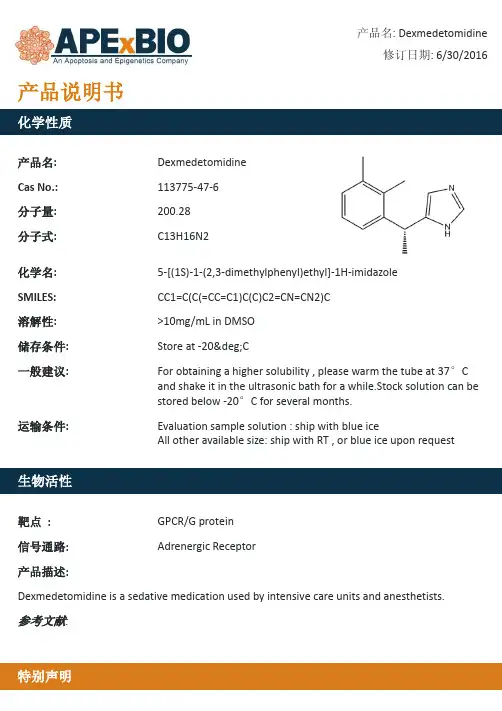
退黄协定方熏洗辅助治疗湿热郁蒸型新生儿病理性黄疸临床观察张春宇傅根莲王甜甜韩姿傅建飞关键词新生儿病理性黄疸;湿热郁蒸型;中药熏洗新生儿病理性黄疸是新生儿期最常见的疾病,治疗不及时严重者可导致胆红素脑病即核黄疸的发生,使中枢神经系统受损,甚至引起死亡或严重的后遗症[1-2]。
中医称之为“胎黄”,常分“湿热郁蒸”、“寒湿镜手术中应用丙泊酚联合瑞芬太尼全凭静脉麻醉与七氟醚吸入麻醉相比,认为丙泊酚静脉麻醉控制机体应激反应的效果优于七氟醚吸入麻醉。
右美托咪定是一种高选择性α2肾上腺素受体激动药,Talke 等[9]研究显示α2肾上腺素能受体激动药通过抑制交感活性,削弱应激反应,减少应激激素的分泌。
因此,理论上右美托咪定能减少七氟醚引起的术后躁动。
右美托咪定还具有协同阿片类药物抑制痛觉神经递质(如P 物质)的释放而产生节约镇痛药物的效应[10],本研究中,治疗组患者瑞芬太尼用量明显少于对照组(P <0.05),有利于减少因瑞芬太尼引起的术后痛觉过敏以及恶心呕吐[8]。
治疗组自主呼吸恢复时间、苏醒时间、拔管时间均短于对照组(P <0.05),提示右美托咪定并不延长七氟醚麻醉的苏醒时间。
因右美托咪定可提供良好的镇静镇痛效果,拔管后,治疗组患者的Ramsay 镇静评分明显高于对照组,且呛咳发生率明显低于对照组(P <0.05),这与Aksu 等[11]的研究相符。
妇科腹腔镜手术患者是术后恶心呕吐高发人群,本研究中两组患者恶心呕吐发生率比较差异无统计学意义,提示采用右美托咪定复合七氟醚麻醉时,应提前使用止吐药。
综上所述,妇科腹腔镜手术采用右美托咪定复合七氟醚全麻时,可以缩短患者苏醒时间,减少患者苏醒期的不良反应,配合使用止吐药可明显提高患者全麻苏醒期质量。
参考文献[1]Weldon BC ,Bell M ,Craddock T.The effect of caudalanalgesia on emergence agitation in children after sevo -flurane versus halothane anesthesia [J ].Anesth Analg ,2004,98(2):321-326.[2]Kamibayashi T ,Maze M.Clinical uses of alpha2-adrenergic agonists [J ].Anesthesiology ,2000,93(5):1345-1349.[3]郎景和.新世纪的妇科腹腔镜手术[J ].中国实用妇科与产科杂志,2003,19(11):641-643.[4]邓小明,姚尚龙,于布为,等.现代麻醉学(上册)[M ].北京:人民卫生出版社,2014:914-915.[5]刘玲,纪风涛,刘付宁,等.右美托咪定对老年患者腰-硬联合麻醉的镇静效应[J ].临床麻醉学杂志,2011,27(1):49-51.[6]柴小青,方才.比洛芬酯预防/减少全麻术后躁动与咽喉疼痛的临床观察[J ].临床麻醉学杂志,2006,22(11):845-846.[7]Kulka PJ ,Bressem M ,Tryba M.Clonidine prevents sevo-flurane -induced agitation in children [J ].Anesth Analg ,2001,93(2):335-338.[8]Marana E ,Colicci S ,Meo F ,et al.Neuroendocrine stressresponse in gynecological laparoscopy :TIVA with propofol versus sevoflurane anesthesia [J ].J Clin Anesth ,2010,22(4):250-255.[9]Talke P ,Chen R ,Thomas B ,et al.The hemodynamic andadrenergic effects of perioperative dexmedetomidine infu -sion after vascular surgery [J ].Anesth Analg ,2000,90(4):834-839.[10]Arcangeli A ,D'Al òC ,Gaspari R.Dexmedetomidine use ingeneral anaesthesia [J ].Curr Drug Targets ,2009,10(8):687-695.[11]Aksu R ,Akin A ,Bicer C ,et parison of the effects ofdexmedetomidine versus fentanyl on airway reflexes andhemodynamic responses to tracheal extubation duringrhinoplasty :A double -blind ,randomized ,controlled study[J ].Curr Ther Res Clin Exp ,2009,70(3):209-220.(收稿:2017-08-10修回:2017-12-15)基金项目:浙江省中医药科技计划项目(No.2017ZA112)作者单位:杭州市红十字会医院儿科(杭州310003)通信作者:张春宇,E-mail :2425994409@阻滞”、“气滞血瘀”三种证型,临床以湿热型最为常见。
右美托咪定在焦虑、抑郁、睡眠障碍中的研究进展2023右美托咪定(dexmedetomidine,Dex)是一种新型镇静药物,主要通过高选择性激活《2肾上腺素能受侬alpha2adrenergicreceptor,α2-AR)发挥镇静、镇痛、中枢性抗交感等作用,被广泛应用于临床麻醉和重症监护治疗病房(intensivecareunit,ICU\与其他镇静类药物不同,Dex可以通过内源性促进睡眠通路,产生类似非快速眼动睡眠(non-rapideyemovementsleep,NREM),并且在一定剂量范围内保留机体的唤醒功能。
近年来的研究发现,Dex可以快速调节焦虑、抑郁、狂躁等负面情绪,同时具有神经保护作用、成瘾性低等特征,在治疗精神障碍方面具有独特的优越性。
因此,本文将重点讨论Dex在焦虑、抑郁、睡眠障碍中的应用,探讨其在精神病学领域中的潜在价值,为临床精神障碍的治疗提供新的思路。
1DeX在焦虑中的应用焦虑是一种以恐惧、紧张、忧虑和烦躁为主的情绪反应,当其症状强烈或持续存在时,可能发展为病理性的〃焦虑状态〃或〃焦虑障碍〃,导致心率加快、头晕、头痛、肌肉紧张等躯体不适,甚至影响患者的日常功能。
病理性焦虑通常需要接受临床治疗,一线治疗主要包括选择性5混色胺(5・hydroxytryptamine,5-HT)再摄取抑制剂、5∙HT去甲肾上腺素再摄取抑制剂以及认知行为疗法。
然而,这些治疗方案的起效时间长达数周,患者往往因神经敏感性增加在治疗初期便停止治疗,导致疗效减弱。
此外,对于急性焦虑的患者,常使用苯二氮类药物进行治疗,但可能带来嗜睡、记忆受损、运动协调障碍以及成瘾性等风险。
因此,寻找一种快速起效且副作用小的抗焦虑治疗方案具有重要的临床意义。
1.1DeX抗焦虑的机制目前,焦虑产生的确切机制尚未明确,有研究认为蓝斑去甲肾上腺素能神经系统(locuscoeruleus-noradrenergicsystem,LC-NE)的过度激活是急性应激引发焦虑的关键因素,而选择性抑制LCNE神经元活动可以预防焦虑的产生。
右美托咪定药理特点及对脏器保护作用的研究进展殷国英吴慢慢张晨许国庆李艳美 *( 通讯作者 )发布时间:2023-06-09T07:17:10.733Z 来源:《医师在线》2023年5期作者:殷国英吴慢慢张晨许国庆李艳美 *( 通讯作者 )[导读] 右美托咪定(dexmedetomidine,DEX)作为一种高度选择性 α2 受体激动剂,在临床上不仅可用于镇静和减轻焦虑,还能抑制交感神经、稳定血流动力学、减轻应激反应和发挥抗炎作用,因此,右美托咪定在临床上被广泛应用。佳木斯大学黑龙江佳木斯 154000摘要:右美托咪定(dexmedetomidine,DEX)作为一种高度选择性α2受体激动剂,在临床上不仅可用于镇静和减轻焦虑,还能抑制交感神经、稳定血流动力学、减轻应激反应和发挥抗炎作用,因此,右美托咪定在临床上被广泛应用。此外,越来越多的研究表明右美托咪定具有保护多个器官的作用。本文就右美托咪定的药理特点及其脏器保护作用和相关机制进行综述,为其在临床应用提供参考。关键词:右美托咪定;α2肾上腺素受体;器官保护作用1右美托咪定的药理特点药代动力学:DEX是一种咪唑类衍生物,具有高度选择性地激活α2肾上腺素受体的特性。它的α2受体亲和力比可乐定高8倍(α2与α2受体亲和力之比为1600∶1)。DEX的分布半衰期约为6分钟,消除半衰期大约为2小时。经由颊黏膜给药时,它的吸收效果良好。肌肉注射DEX2μg/kg后,平均12分钟达到血浆峰值浓度,终末半衰期为(281±177)分钟[1]。DEX还表现出很高的亲脂性,几乎完全被生物转化,随后通过粪便和尿液排出。对于那些肝脏或肾脏功能受损者而言,其药物清除率低于正常人,因此DEX应用的剂量应减少[2]。药效动力学:机体的α2肾上腺素受体主要分布于交感神经末梢和中枢神经系统的肾上腺素神经细胞中。这些受体有三种亚型(α2 A、α2 B和α2 C),各自发挥不同的作用。据认为,α2 A受体亚型介导了非选择性α2肾上腺素受体激动剂的镇静和抗交感神经效应,α2 C受体亚型介导了其激动剂的抗焦虑效应。激动剂与α2 B受体亚型结合后可引起短暂的血压升高反应。DEX发挥镇静和催眠效应的机制是作用于蓝斑核,其抗伤害性感受效应则主要是通过对脊髓后角的作用而实现的。此外,DEX还能够通过对外周和中枢的作用来发挥抗交感活性的效应[3]。2 DEX对器官的保护作用2.1脑的保护作用:研究表明,脑缺血和缺氧会导致儿茶酚胺(CA)过度释放,可以导致神经细胞发生钙超载,进而生成大量神经毒性自由基,从而加重缺血和脑积水,增加神经细胞对谷氨酸的敏感性,最终导致神经细胞受损[4-5]。DEX可以有效降低CA的生成,减轻脑血管痉挛和其伴随的脑损伤[6]。此外,创伤性损伤、脑缺血、术后认知功能障碍等问题与神经细胞炎症反应及细胞凋亡密切相关。DEX可以通过抑制TLR4/NF-κB、JAK2-STAT3和NF-κB/COX-2通路抑制神经细胞炎症产生,从而发挥保护作用。DEX还能够通过减少神经细胞凋亡发挥保护效应。细胞程序性死亡被称为细胞凋亡,它是由多种基因介导的。关键的凋亡调节蛋白包括Bcl-2、BCL-XL和Bax。研究表明右美托咪定直接作用于α2 A受体,促进脑源性神经营养因子(BDNF)的表达。BDNF通过调节ERK1/2通路,激活PI3K/Akt信号通路和MAPK通路,同时抑制p38和c-Jun N-末端激酶(JNK)通路,从而促进了Bcl-2和BCL-XL的表达,减少神经细胞凋亡[7]。2.2心脏的保护作用:患者在手术过程中容易受到外科手术、气管插管等刺激,可能会引起机体交感神经兴奋,导致心脏并发症,如心动过速、血压升高、心肌缺血等。DEX通过降低交感神经的兴奋性,减弱应激反应,稳定血流动力学,有效预防围手术期心肌缺血。据临床观察证实,DEX可降低术后死亡率和心肌梗死概率[8-9]。据文献[10]检索发现,DEX的心脏保护机制主要有三个方面:(1)抑制蓝斑核去甲肾上腺素神经细胞活性,降低血液中CA水平、心脏负荷和心肌耗氧量,同时增加左室冠状动脉血流量,提高心肌对缺血缺氧的抵抗力;(2)去甲肾上腺素(NE)大量释放能导致心律失常的风险增高,DEX能通过减少NE的释放,降低高风险患者心律失常发生的概率;(3)当心脏缺血再灌注(IR)损伤之前应用DEX,可以激活PI3K/Akt、MEK1/2-ERK1/2等信号通路,减弱IR引起的细胞凋亡和炎症反应,从而缩小心肌梗死面积。但其下游分子机制仍有待于进一步研究发现。2.3肺脏的保护作用:肺是一个敏感的器官,易遭受到全身炎症反应综合征(SIRS)和远端器官IR损伤的影响。许多临床实践,如创伤、单肺通气、体外循环和肝移植,都可能引起肺损伤,主要通过炎症和细胞凋亡来实现。近年来的研究表明,DEX通过影响肺血管的收缩机制以及炎性因子的释放等作用,可以在许多肺损伤的情况下发挥肺保护作用。研究发现在肾IR损伤造成的急性肺损伤实验中,发现髓过氧化物酶、细胞间粘附分子-1及TNF-α mRNA的表达会显著升高。DEX能下调它们的表达水平,显著减弱炎症反应,从而减轻肺水肿[11-12]。Lameire等[13]在脓毒症大鼠模型中发现,DEX能通过TLR4/MyD88/NF-κB信号通路抑制肺部炎症反应。吴晓静[14]等在大鼠胸部创伤模型中发现,NF-κB的活性会增强,DEX可以抑制其活性,降低促炎因子的表达,进而对肺挫伤产生保护作用。此外实验[15]发现,DEX还可以减轻脂多糖(LPS)诱导的急性肺损伤中的线粒体氧化应激和细胞凋亡,并发现DEX对肺保护作用的强度与其浓度呈抛物线关系。2.4肾脏的保护作用:肾脏是一个重要的器官,占据了心输出量的20%,其中90%-95%分布在皮质。围手术期的休克、血管活性药物的应用都容易造成肾实质特别是肾皮质损伤。IR会导致交感神经活动增强,引起肾皮质血管收缩加剧。DEX可以通过局部舒张肾脏血管来改善肾外髓质的血流量,提高肾小球过滤率,减弱精氨酸加压素在集合管的作用,减少水通道蛋白的表达,促进尿液排泄,从而改善肾脏缺血损伤[16-17]。DEX还可以扩张机体血管、加快血液循环、减少红细胞聚集所造成血液瘀滞,从而减轻IR对肾脏的危害。此外,肾IR损伤会导致TLR4/NF-κB、JAK/STAT信号通路被激活,引起NF-κB的转录增多,而NF-κB是炎症相关酶诱导型一氧化氮合酶的启动子,NF-κB表达上调可促进一氧化氮释放,造成氧化应激水平上升,线粒体损伤加重。DEX可以抑制上述途径,从而减轻肾IR损害[10]。2.5肝脏的保护作用:IR会造成肝脏不同程度的损害,严重影响患者的预后。肝组织IR损害后可见肝窦淤血、炎性细胞浸润、局灶性坏死。肝组织损害的过程极其复杂,常常伴随细胞内信号通路、细胞和病理生理学的改变[18]。张世霞[19]等研究发现,肝IR之前应用DEX能显著提高BRL-3A细胞的超氧化物歧化酶和谷胱甘肽活性,同时降低了活性氧和丙二醛的水平,缓解了氧化应激,减轻了肝脏IR损害。另一项研究[20]显示,DEX可以减轻LPS引起的肝损伤。其是因为DEX可以引起乙酰胆碱、α7 烟碱型乙酰胆碱受体表达上升,TLR4、MyD88、NF-κB表达下降,降低肿瘤坏死因子-α、白介素-6等炎症因子的水平,减弱了炎症反应,最终减轻了LPS所造成的肝损害。同时该研究还发现DEX预处理后,可以调节肝细胞凋亡相关蛋白caspase-3和Bcl-2的表达,抑制了肝细胞凋亡,从而发挥保护肝脏作用。但α7nAChR与TLR4活化的关系有待进一步研究。3结语综述所述,DEX是一种常用的临床药物,由于其广泛的应用价值而值得推广。它能通过多种机制对大脑、心脏等多个器官产生保护作用,但仍有部分机制尚未未完全清楚,仍需更多的基础和临床实验来阐明。参考文献[1]张青,王竹梅.右美托咪啶的药理作用及临床应用进展[J].贵州医药, 2016, 40(5): 544-546.[2]赵秀洁, 王业文, 宋倩倩, 等. 右美托咪定药理作用及肺保护作用机制的研究进展[J]. 中国医学创新, 2022, 19(33): 185-188.[3]张燕, 郑利民. 右美托咪啶的药理作用及临床应用进展[J]. 国际麻醉学与复苏杂志, 2007, 28(6):544-547.[4] J. Lutz, L. A. Luong, M. Strobl et al., “The A20 gene protects kidneys from ischaemia/reperfusion injury by suppressing pro-inflammatory activation,” Journal of Molecular Medicine (Berlin, Germany), vol. 86, no. 12, article 405, pp. 1329–1339,2008.[5] C. G. da Silva, E. R. Maccariello, S. W. Wilson et al.,“Hepatocyte growth factor preferentially activates the anti-inflammatory arm of NF-κB signaling to induce A20 and protect renal proximal tubular epithelial cells from inflammation,” Journal of Cellular Physiology, vol. 227,no. 4, pp. 1382–1390, 2012.[6] U. Kunter, S. Daniel, M. B. Arvelo et al., “Combined expression of A1 and A20 achieves optimal protection of renal proximal tubular epithelial cells,” Kidney International,vol. 68, no. 4, pp. 1520–1532, 2005.[7] ZHAO Y, HE J, YU N, et al. Mechanisms of Dexmedetomidine in Neuropathic Pain[J/OL]. Frontiers in Neuroscience, 2020, 14: 330.[8] D. N. Wijeysundera, J. S. Naik, and W. S. Beattie, “Alpha-2 adrenergic agonists to prevent perioperative cardiovascular complications: a meta-analysis,” The American Journal of Medicine, vol. 114, no. 9, pp. 742–752, 2003.[9] B. M. Biccard, S. Goga, and J. de Beurs, “Dexmedetomidine and cardiac protection for non-cardiac surgery: a meta-analysis of randomised controlled trials,” Anaesthesia,vol. 63, no. 1, pp. 4–14, 2008.[10] BAO N, TANG B. Organ-Protective Effects and the Underlying Mechanism of Dexmedetomidine[J/OL]. Mediators of Inflammation, 2020, 2020: 6136105.[11] J. Gu, J. Chen, P. Xia, G. Tao, H. Zhao, and D. Ma, “Dexme-detomidine attenuates remote lung injury induced by renal ischemia-reperfusion in mice,” Acta Anaesthesiologica Scan-dinavica, vol. 55, no. 10, pp. 1272–1278, 2011.[12] N. Bao and D. Dai, “Dexmedetomidine protects against ischemia and reperfusion-induced kidney injury in rats,”Mediators of Inflammation, vol. 2020, Article ID 2120971,8 pages, 2020.[13] N. H. Lameire, A. Bagga, D. Cruz et al., “Acute kidney injury:an increasing global concern,” Lancet, vol. 382, no. 9887,pp. 170–179, 2013.[14] X. Wu, X. Song, N. Li, L. Zhan, Q. Meng, and Z. Xia, “Protec-tive effects of dexmedetomidine on blunt chest trauma-induced pulmonary contusion in rats,” Journal of Trauma and Acute Care Surgery, vol. 74, no. 2, pp. 524–530, 2013.[15] C. Fu, X. Dai, Y. Yang, M. Lin, Y. Cai, and S. Cai, “Dexmede-tomidine attenuates lipopolysaccharide-induced acute lung injury by inhibiting oxidative stress, mitochondrial dys function and apoptosis in rats,” Molecular Medicine Reports,vol. 15, no. 1, pp. 131–138, 2017.[16] F. T. Billings, S. W. C. Chen, M. Kim et al., “α2-Adrenergic agonists protect against radiocontrast-induced nephropathy in mice,” American Journal of Physiology-Renal Physiology,vol. 295, no. 3, pp. F741–F748, 2008.[17] A. J. Rouch, L. H. Kudo, and C. Hebert, “Dexmedetomidine inhibits osmotic water permeability in the rat cortical collecting duct,” The Journal of Pharmacology and Experimental Therapeutics, vol. 281, no. 1, pp. 62–69, 1997.[18] TÜFEK A, TOKGÖZ O, ALIOSMANOGLU I, elat.The protective effects of dexmedetomidine on the liver and remote organs against hepatic ischemia reperfusion injury in rats[J/OL]. International Journal of Surgery (London, England), 2013, 11(1): 96-100.[19] ZHANG S, TANG J, SUN C, et al. Dexmedetomidine attenuates hepatic ischemia-reperfusion injury-induced apoptosis via reducing oxidative stress and endoplasmic reticulum stress[J/OL]. International Immunopharmacology, 2023, 117: 109959.[20] ZI S F, LI J H, LIU L, et al. Dexmedetomidine-mediated protection against septic liver injury depends on TLR4/MyD88/NF-κB signaling downregulation partly via cholinergic anti-inflammatory mechanisms[J/OL]. International Immunopharmacology, 2019, 76: 105898.。
NEUROSCIENCES AND NEUROANAESTHESIADexmedetomidine,an a 2-adrenergic agonist,inhibits neuronaldelayed-rectifier potassium current and sodium currentB.-S.Chen 13,H.Peng 2and S.-N.Wu 12*1Institute of Basic Medical Sciences and 2Department of Physiology,National Cheng Kung University Medical College,No.1,University Road,Tainan 70101,Taiwan,Republic of China.3Department ofAnesthesiology,Buddhist Dalin Tzu Chi General Hospital,Chiayi County,Taiwan,Republic of China*Corresponding author.E-mail:snwu@.twBackground.Dexmedetomidine (DEX),a selective agonist of a 2-adrenergic receptors,isrecognized to facilitate analgesia and anaesthesia in humans.Despite the potential for wideuse,its effects on ion currents and membrane potential in neurones remain largely unclear.Methods.W e investigated the effects of DEX on ion channels in NG108-15neuronal cells dif-ferentiated with dibutyryl cyclic AMP and in cultured cerebellar neurones.Results.DEX suppressed the amplitude of delayed rectifier K +current [I K(DR)]in a concen-tration-dependent manner with an IC 50value of 4.6m M in NG108-15cells.No change in thesteady-state inactivation of I K(DR)was evident in the presence of DEX.A minimal bindingscheme was also used to evaluate DEX-induced block of I K(DR).Inhibition of I K(DR)by DEXwas still observed in cells preincubated with yohimbine (10m M)or efaroxan (10m M).DEXdepressed the peak amplitude of Na +current (INa ),whereas it had minimal effect on L-typeCa 2+current.Under current-clamp configuration,DEX increased the duration of action poten-tials (APs).I K(DR)and I Na in response to AP waveforms were more sensitive to block by DEXthan those elicited during rectangular pulses.In isolated cerebellar granule cells,DEX alsoeffectively suppressed I K(DR).Conclusions.The effects of DEX are not limited to its interactions with a 2-adrenergic recep-tors.Inhibitory effects on I K(DR)and I Na constitute one of the underlying mechanisms throughwhich DEX and its structurally related compounds might affect neuronal activity in vivo .Br J Anaesth 2009;103:244–54Keywords :ions,ion channels,pharmacology;ions,ion channels,voltage-gated;model,neuroblastoma cells;pharmacology,dexmedetomidineAccepted for publication:April 7,2009Dexmedetomidine (DEX)is a potent and highly selective agonist of the a 2-adrenergic receptors that is approved by the US Food and Drug Administration for the provision of short-term sedation of adult patients in the intensive care unit.It exerts a variety of actions on the human brain,including sedation,anaesthetic-sparing effects,and analge-sia.12Because this agent has minimal effects on venti-lation,it is relatively safe in the setting of functional neurosurgery.3Its sedative action is thought to involve inhibition of the locus coeruleus and subsequent disinhibi-tion of the ventrolateral preoptic nucleus.4DEX has been reported to decrease the convulsive potency of bupivacaine and levobupivacaine in awake rats.5A recent study showed that as an anaesthetic adjunct,DEX at a high concentration can affect transcranial motor evoked responses.6However,there are limited reports regarding its ionic mechanism of action on neurones.Recent evidence has emerged that the effects on ion channels may be an important mechanism underlying DEX-induced actions in neurones.For example,previous studies demonstrated the ability of DEX to modify L-type Ca 2+current (I Ca,L )in pheochromocytoma cells 7and to inhibit M 3muscarinic receptors in dorsal root ganglion cells.8In paraventricular nucleus neurones or substantia gelatinosa neurones,DEX increases G-protein-coupled inwardly recti-fying K +currentand inhibits hyperpolarization-elicited inward current.910Voltage-gated K +(K V )channels play an essential role in determining the excitability of neurones.#The Author [2009].Published by Oxford University Press on behalf of The Board of Directors of the British Journal of Anaesthesia.All rights reserved.British Journal of Anaesthesia 103(2):244–54(2009)doi:10.1093/bja/aep107Advance Access publication June 20,2009Among them,delayed rectifier K +(K DR )channels are ubi-quitous in neurones.In fast-spiking neurones,a causal relationship between K V 3,especially K V 3.1,and the delayed rectifier K +current [I K(DR)]has been well estab-lished.The K V 3recombinant channel has properties suit-able for the generation of high-frequency firing.High activation threshold (about 220mV)and fast deactivationkinetics of the channels make them ideal for narrowingspike width and inter-spike interval.11The I K(DR)containingK V 3subunits contributes to changes in membrane potential in differentiated NG108-15cells.12–14Previous studies in our laboratory have shown that tra-madol suppresses the amplitude of I K(DR)in NG108-15cells.14If K V 3-encoded K +currents are located at nerve terminals,modulation of current amplitude might be expected indirectly to alter Ca 2+influx and to affect neuro-transmitter release in the absence of overt changes in firing patterns.1115However,whether DEX can interact with I K(DR)or other types of ion currents to modify mem-brane potential in neurones remains largely unclear,despite its clinical use in a variety of neurosurgical pro-cedures.2–4In this study,we investigated the effects of DEX on ion currents (e.g.delayed rectifier K +current [I K(DR)],Na +current [I Na ],and L-type Ca 2+current [I Ca,L ])and mem-brane potential in NG108-15neuronal cells differentiated with dibutyryl cyclic AMP and in cultured cerebellar neur-ones.DEX was able to suppress both I K(DR)and I Na .The major action of DEX on I K(DR)is thought to be through anopen-channel mechanism.These inhibitory effects are not mediated by a 2-adrenergic receptors and might contributeto its pharmacological actions in vivo .Methods Drugs and solutions DEX (dexmedetomidine HCl;(S )-4-[1-(2,3-dimethylphenyl)ethyl]-1H-imidazole hydrochloride;Precedex w )was obtained from Abbott Laboratories (Abbott Park,IL,USA).Collagenase,dibutyryl cyclic AMP,DNase I,efaroxan,tetraethylammonium chloride,and tetrodotoxin were purchased from Sigma Chemicals (St Louis,MO,USA),and yohimbine was from Tocris (Bristol,UK).Tissue culture media,L -glutamine penicillin–streptomycin,fungi-zone,and trypsin were obtained from Life Technologies (Carlsbad,CA,USA).All other chemicals,including CsCl 2and CdCl 2,were commercially available and of reagent grade.The composition of normal Tyrode’s solution was 136.5mM NaCl,5.4mM KCl,1.8mM CaCl 2,0.53mM MgCl 2,5.5mM glucose,and 5.5mM HEPES–NaOH buffer,pH 7.4.To record I K(DR)or membrane potential,the patch pipette was filled with a solution consisting of 140mM KCl,1mM MgCl 2,3mM Na 2ATP,0.1mM Na 2GTP,0.1mM EGTA,and 5mM HEPES–KOH buffer,pH 7.2.To measure I Na or I Ca,L ,K +ions inside the pipette solution were replaced with equimolar Cs +ions,and the pH was adjusted to 7.2with CsOH.In some experiments,the pipette was filled with the solution which contained 10m M DEX.Cell preparation and differentiationThe clonal strain NG108-15cell line,formed by Sendaivirus-induced fusion of the mouse neuroblastoma cloneN18TG-2and the rat glioma clone C6BV-1,was obtained from the European Collection of Cell Cultures(ECACC-88112302;Wiltshire,UK).Cellswere kept in monolayer cultures at a density of 106ml 21in plastic disks containing Dulbecco’s modified Eagle’s medium supplemented with 100m M hypoxanthine,1m M amino-pterin,16m M thymidine,and 5%fetal bovine serum asthe culture medium,in a humidified incubator equilibrated with 90%air/10%CO 2at 378C.14Media were replenished every 2–3days with fresh media.To induce neuronal differentiation,culture medium was replaced with medium containing 1mM dibutyryl cyclic AMP and cells were cultured in the incubator for 1–7days.16In a separate set of experiments,differentiated NG108-15cells were prein-cubated with yohimbine (10m M)or efaroxan (10m M)for 5h before electrophysiological experiments were performed.Isolation of cerebellar granule cellsCerebellar granule cells were isolated from Wistar rat pupsof post-natal days 9–10.Cerebella of 5–7animals wereexcised after decapitation,and minced and digested withcollagenase (50mg ml 21)for 10min.Mechanical tritura-tion with a Pasteur pipette was made in a DNase I/soybeantrypsin inhibitor solution.Dissociated cells were centri-fuged and suspended in normal Tyrode’s solution.Cells were used for experiments within 2–3h after isolation.Animal experiments were conducted according to the pro-tocols that follow the NIH standards and the guidelines for the Care and Use of Experimental Animals.The procedure was approved by the Animal Care and Use Committee of the National Cheng Kung University,Tainan,Taiwan,Republic of China.Electrophysiological measurementsImmediately before each experiment,cells were disso-ciated and an aliquot of cell suspension was transferred to a recording chamber mounted on the stage of an inverted DM-IL microscope (Leica,Wetzlar,Germany).Cells were bathed at room temperature (20–258C)in normal Tyrode’ssolution containing 1.8mM CaCl 2.Patch pipettes werepulled from Kimax-51glass capillaries (Kimble Glass,Vineland,NJ,USA)on a PP-830microelectrode puller (Narishige,Tokyo,Japan),and their tips were fire-polishedDexmedetomidine inhibits neuronal ion currentsby on August 7, 2010 Downloaded fromwith an MF-83microforge (Narishige).The resistances of the patch pipettes when filled with the internal solutions were between 3and 5M V .Ion currents were measured with glass pipettes in a whole-cell configuration of the patch-clamp technique,using an RK-400patch-clamp amplifier (Biologic,Claix,France).1317Data recordings and analyses Signals were displayed on an HM-507oscilloscope (Hameg Inc.,East Meadow,NY,USA).Data were stored online in a Slimnote VX 3computer (Lemel,Taipei,Taiwan)at 10kHz equipped with a Digidata-1322A inter-face (Molecular Devices,Sunnyvale,CA,USA).Series resistance,in the range of 5–15M V ,was electronically compensated.Data were analysed by the use of pCLAMP9.0software (Molecular Devices),Origin 7.5software(Microcal Software,Northampton,MA,USA),or custom-made macros built in Excel 2007spreadsheet running onWindows Vista (Microsoft,Redmond,WA,USA).ThepCLAMP-generated voltage-step protocols were used to measure the current–voltage (I–V )relations for ion cur-rents.Action potential duration (APD)was measured at 90%of repolarization (APD 90).To evaluate the percentage inhibition of DEX on I K(DR),NG108-15cells were bathed in normal Ca 2þ-free Tyrode’s solution and each cell was depolarized from 250to +50mV.The amplitude of I K(DR)at the end of depolarizing pulse during exposure to different concentrations (0.1–30m M)of DEX was measured.Concentration–response data for inhibition of I K(DR)were fitted with a modified form of the Hill equation:y ¼ð1Àa Þ½DEX Àn H½DEX Àn H þIC Àn H 50þa ;where y is the normalized amplitude of I K(DR);[DEX]rep-resents the DEX concentration;and IC 50and n H are the concentration required for 50%inhibition and Hill coeffi-cient,respectively.Maximal inhibition (i.e.12a )was also estimated.By the use of a least squares method,the smooth curve shown in Figure 1B was allowed to converge on the experimental data when the maximal block was left undefined.Time constants of current activation (t act )in the absence or presence of DEX were determined by fittingthe trajectory of each current trace with single exponentialcurves.To determine the effect of DEX on the steady-state inactivation of I K(DR),the relationship between the con-ditioning potentials and the normalized amplitude of I K(DR)obtained with or without addition of DEX (3m M)was fitted by the Boltzmann function:I ¼I max 1þexp ðV Àa =b Þwhere I max represents the maximal activated I K(DR),V is the membrane potential in mV,a the membrane potential for a half-maximal inactivation,and b the slope factor of the inactivation curve of I K(DR).Values are provided as means (SEM )with sample sizes (n )indicating the number of cells from which the data were taken.The paired or unpaired Student’s t -test andone-way analysis of variance (ANOV A )with the least signifi-cant difference method for multiple comparisons were used for the statistical evaluation of differences among means.Non-parametric Kruskal–Wallis test was then used,if the assumption of normality underlying ANOVA wasviolated.Statistical analyses were performed using SPSS 14.0(SPSS Inc.,Chicago,IL,USA).Statistical signifi-cance was determined at a P -value of ,0.05.ResultsEffect of DEX on delayed rectifier K +current [I K(DR)]in differentiated NG108-15cellsIn an initial set of experiments,a whole-cell configuration of the patch-clamp technique was used to evaluate the effects of DEX on ion currents in NG108-15cells differ-entiated with dibutyryl cyclic AMP (1mM).To record I K(DR),cells were bathed in Ca 2+-free Tyrode’s solution which contained tetrodotoxin (1m M)and CdCl 2(0.5mM),and the recording pipette was filled with a K +-containing solution.Figure 1shows that DEX can depress the amplitude of I K(DR)in a concentration-dependent manner.In these experiments,each cell wasdepolarized from 250to +50mV with a duration of 300ms,and current amplitudes of I K(DR)were measured at theend of depolarizing pulses.DEX (0.1–30m M)suppressedthe amplitude of I K(DR)in a concentration-dependentmanner.The relationship between the DEX concentration and the percentage inhibition of I K(DR)was constructed and plotted in Figure 1B .The IC 50value for DEX-induced inhibition of I K(DR)was 4.6m M.Figure 1C illustrates aver-aged I–V relationships of I K(DR)obtained in the control and during cell exposure to 3m M DEX.The results demonstrate that DEX has a significant depressant action on I K(DR)functionally expressed in differentiated NG108-15cells.Kinetic studies of DEX-induced block of I K(DR)Because the activation time course of I K(DR)during exposure to DEX tends to be progressively reduced,it is important to determine the kinetics of DEX-induced block in these cells.As shown in Figure 1D ,when cells weredepolarized from 250to +50mV,exposure to DEX wasnoted to produce a reduction of t act in a concentration-dependent fashion.Therefore,the results suggest that theinhibitory effects of DEX on I K(DR)can be primarilyexplained by state-dependent blocker where it can bind toChen et al.by on August 7, 2010 Downloaded fromthe open state of the channel according to the minimal kinetic scheme:18C O O · Dwhere a and b are kinetic constants for the opening andclosing of the channel,k 1and k 21are those for forward and reverse rate constants of DEX binding,and D is theDEX concentration.C,O,and O .D represent the closed,open,and open-bound states,respectively.Forward and reverse rate constants,k 1and k 21,were estimated from the values of tact for DEX-induced change in the trajectory ofI K(DR)(Fig.1E ).The values were calculated using therelation:t À1¼k 1½D þk À1In particular,k 1and k 21,respectively,result from the slope and from the y -axis intercept at [D ]=0of the linear p A 1000020003000–50050m V [DEX] (μM)D A C u rr e n t a m p li t ude (pA)ms 002000e d c b a pA 2040Time (ms)Fig 1Inhibitory effect of DEX on I K(DR)in NG108-15cells differentiated with dibutyryl cyclic AMP.Cells were bathed in Ca 2+-free Tyrode’s solution that contained tetrodotoxin (1m M)and CdCl 2(0.5mM).(A )Superimposed current traces obtained in the absence and presence of DEX.The upper part indicates the voltage protocol used.Inset shown in the right side of (A )indicates expanded time scale of current traces (dashed box).a,control;b,0.1m M DEX;c,0.3m M DEX;d,1m M DEX;and e,3m M DEX.(B )Concentration–response relationship for DEX-induced inhibition of I K(DR).Each cell was depolarized from 250to 50mV.Each point represents the mean (SEM )value (n =6–9).The smooth line represents the best fit to the Hill equation as described in Methods.The IC 50value was derived from the non-linear curve fit.The IC 50value,maximally inhibited percentage of I K(DR),and Hill coefficient (n H )were 4.6m M,90%(i.e.a =0.1),and 1.1,respectively.(C )Averaged I–V relationships of I K(DR)obtained in the absence and presence of 3m M DEX.Mean (SEM )(n =7–12).In (D ),the time courses of current activation in the absence and presence of DEX were well fitted by a single exponential.a,control;b,0.1m M DEX;c,0.3m M DEX;d,1m M DEX;and e,3m M DEX.The inset indicates the voltage protocol used.In (E ),the reciprocal of the activation time constant (t act ),obtained by a single-exponential fit of the increasing phase of I K(DR),was plotted against the DEX concentration.Data points were fitted by a linear regression,suggesting that the interaction occurs with a stoichiometry of 1.Forward (k 1)and reverse (k 21)rate constants,given by the slope and the y -axis intercept of the interpolated line,were 0.056ms 21m M 21and 0.34ms 21,respectively.Each point represents the mean (SEM )value (n =8–11).Dexmedetomidine inhibits neuronal ion currentsby on August 7, 2010 Downloaded fromregression interpolating the reciprocal of time constants (i.e.t 21)vs different DEX concentrations (i.e.[D ]).In agreement with this kinetic scheme,the relationship between k 1and [D ]was found to be linear with a corre-lation coefficient of 0.95(Fig.1E ).The forward and reverse rate constants obtained from 6to 8different cells were calculated to be 0.056ms 21m M 21and 0.34ms 21,respectively.On the basis of these rate constants,a value of 6.1m M for the dissociation constant (K D =k 21Âk 121)ofthis drug was derived.Notably,this value was found to agree with its IC 50value determined from the concen-tration–response curve (Fig.1B ).However,the backward rate constant (i.e.k 21)showed little dependence on theDEX concentration:k 21was 0.34ms 21(n =6)at 1m Mand 0.34ms 21(n =6)at 3m ck of effect of DEX on steady-state inactivation curve of I K(DR)To characterize the inhibitory effect of DEX on I K(DR),wenext investigated whether this drug affects the steady-state inactivation curve of I K(DR)in differentiated NG108-15cells.Figure 2illustrates the steady-state inactivation curve of I K(DR)obtained in the absence and presence of DEX(3m M).In these experiments,a 10s conditioning pulse to different membrane potentials preceded the test pulse to +50mV from a holding potential of 250mV.Therelationships between the conditioning potentials and thenormalized amplitudes of I K(DR)with or without appli-cation of DEX (3m M)were plotted and fitted by the Boltzmann equation as described in Methods.In control,a =212.3(2.2)mV,b =6.6(0.8)mV (n =6),whereas in the presence of DEX (3m M),a =212.1(2.1)mV,b =6.3(0.7)mV (n =6).The values for a and b were not significantly modified in the presence of DEX (3m M),although it reduced the maximal conductance of I K(DR)by about 50%.Effect of DEX on averaged I–V relations of I K(DR)in NG108-15cells treated with yohimbineDEX was reported to be a selective agonist ofa 2-adrenergic receptors.1Previous studies showed the ability of yohimbine to reverse both increased K +outwardcurrents and anticonvulsant effect caused by DEX.5910We next evaluated whether inhibition of a -adrenergic receptors can influence DEX-induced block of I K(DR)inNG108-15cells.In these experiments,differentiated NG108-15cells preincubated with yohimbine (10m M)for5h.Yohimbine is an a 2-adrenoceptor antagonist,whereas efaroxan is an antagonist of imidazoline-I 1and a 2-adrenergic receptors.In yohimbine-treated cells,theinhibitory effect of DEX on the I–V relationship of I K(DR)remained unaltered (Fig.3).No significant difference inthe magnitude of DEX-induced inhibition of I K(DR)between control cells and cells treated with DEX can be seen.Moreover,subsequent application of yohimbine (10m M)or efaroxan (10m M)did not reverse the inhibition ofI K(DR)caused by DEX (3m M)(data not shown).Similarly,in cells treated with efaroxan (10m M)for 5h,the magnitude of DEX-induced inhibition of I K(DR)remained unchanged.These results are thus interpreted to mean that the inhibitory effect of DEX on I K(DR)in these cells is unrelated to its binding to a 2-adrenergic receptors.Effect of DEX on voltage-gated Na +current (I Na )in differentiated NG108-15cellsWe next investigated whether DEX has any effects on I Na present in these cells.Cells were bathed in Ca 2+-free Tyrode’s solution containing 0.5mM CdCl 2and the pipette was filled with a Cs +-containing solution.The effect of DEX on I Na was examined at different potentials and an I–V relationship of I Na was constructed.As shownI/Im axConditioning potential (mV)BC u r re n ta m pli tud e(pA )010 000Time (ms)500020 00015 0000100020003000A ms 0–50050mV 10000Fig 2Steady-state inactivation curve of I K(DR)in the absence or presence of DEX in differentiated NG108-15cells.Conditioning voltage pulses with a duration of 10s to potentials between 260and +60mV were applied from a holding potential of 250mV.After each conditioning pulse,a test pulse to +50mV was applied to evoke I K(DR).An example of current traces obtained by two-pulse protocol in the control is illustrated in (A ).The inset shown in (A )indicates the voltage protocol used.(B )Steady-state inactivation curve of I K(DR)obtained with or without application of DEX (3m M).The normalized amplitude of I K(DR)(I /I max )was constructed against the conditioning potentials,and the smooth curves were fitted by the Boltzmann equation (see text for details).Mean (SEM )(n =5–9).Note that the steady-state inactivation curves of I K(DR)in the absence and presence of DEX are virtually superimposable.Chen et al.by on August 7, 2010 Downloaded fromin Figure 4,DEX at a concentration of 10m M could significantly decrease the peak amplitude of I Na ,whencells were depolarizing from 280mV to different poten-tials ranging from 280to +40mV.For example,when the cell was depolarized from 280to 240mV,application of DEX (10m M)significantly decreased I Na from 0.79(0.07)to 0.62(0.07)nA (n =7).After washout of the drug,I Nawas returned to 0.76(0.06)nA (n =6).However,the overall I–V configuration of I Na did not differ between theabsence and the presence of DEX.A subsequent appli-cation of yohimbine (10m M)did not reverse the inhibition of I Na caused by DEX (data not shown).Lack of effect of DEX on L-type Ca 2+current (I Ca,L )in differentiated NG108-15cellsPrevious reports showed that DEX is able to modify Ca 2+current in phaeochromocytoma cells.7We also determined the ability of this agent to alter the amplitude of I Ca,L inthese cells.The experimental results are illustrated inFigure 5.When the cell was depolarized from 240to different potentials ranging from 240to +40mV,thepeak amplitude of I Ca,L was not found to differ between the absence and the presence of 10m M DEX.Moreover,when cells were exposed to this agent,no modification ofthe I–V relationship of I Ca,L can be demonstrated.Therefore,unlike I Na ,I Ca,L is relatively insensitive to inhi-bition by DEX in these cells.Effect of DEX on action potentials in differentiated NG108-15cellsIn another set of experiments,we determined the ability ofDEX to alter membrane potential.In these experiments,cells were bathed in normal Tyrode’s solution containing 1.8mM CaCl 2,and current-clamp recordings were madein a K +-containing pipette solution.The resting membranepotential and APD measured at 90%repolarization(APD 90)in differentiated NG108-15cells were 270(8)mV and 119(20)ms,respectively (n =21).A representativeexample of DEX-induced effects on action potentials(APs)in differentiated NG108-15cells is illustrated inFigure 6.DEX at a concentration of 10m M significantly decreased the amplitude of APs from 86(3)to 75(3)mV and prolonged the duration of APs from 76(9)to 143(21)ms (n =7).However,no discernible change in resting mem-brane potential can be demonstrated in the presence of C u rre n ta mp l itud e(n A)m V Control DEXTime (ms)050100150Fig 4Inhibitory effect of DEX on I Na in differentiated NG108-15neuronal cells.Cells were bathed in Ca 2+-free Tyrode’s solution containing 10mM tetraethylammonium chloride and 0.5mM CdCl 2.The recording pipette was filled with a Cs +-containing solution.(A )Superimposed current traces when the cell was depolarized from 280mV to different potentials.Upper panel is the control,and lower panel was obtained 2min after application of 10m M DEX.The uppermost part indicates the voltage protocol used.(B )Averaged I–V relationships of peakI Na obtained in the absence or presence of 10m M DEX.Mean (SEM )(n =6–11).DEX reduced the peak amplitude of I Na with no change in the overall I–V configuration.C ur re n tam pli tu d e(p A )Membrane potential (mV)Fig 3Effect of DEX on averaged I–V relationships of I K(DR)inNG108-15cells treated with yohimbine.Before each experiment,cells were preincubated with yohimbine (10m M)for 5h.In each cell examined,I K(DR)was elicited from 250mV to different potentials ranging from 250to +50mV with 10mV increments.The I–V relationships of I K(DR)obtained in the absence or presence of 3m M DEX are illustrated.Mean (SEM )(n =5–10).Dexmedetomidine inhibits neuronal ion currentsby on August 7, 2010 Downloaded fromDEX.The widening of APs caused by DEX could be pri-marily explained by its block of I K(DR)and I Na ,but not by the activation of I Ca,L .Inhibitory effects of DEX on ion currents in response to AP waveforms in differentiated NG108-15cells The size and time course of ion currents [e.g.I Na andI K(DR)]in response to change in AP waveforms tend to bedifferent from those elicited by rectangular voltage-clamp pulses.The effects of DEX on ion currents during APs generated from NG108-15cells were also investigated.In these experiments,cells were bathed in normal Tyrode’s solution,and the waveforms of APs were digitally gener-ated as voltage templates and replayed to evoke ion cur-rents.19As shown in Figure 7,the amplitudes of I Na andI K(DR)in response to AP waveforms were reduced in thepresence of DEX.For example,after application of 1m MDEX,the peak amplitude of I Na elicited by the waveforms of APs was decreased by about 10%.Moreover,I K(DR)in response to AP waveforms was suppressed by about 30%.The results led us to suggest that I Na and I K(DR)evoked by AP waveforms are more sensitive to block by this agent than those during rectangular pulses.Effect of DEX on I K(DR)in isolated rat cerebellargranule cells Previous studies have demonstrated the presence of I K(DR)(i.e.K V 3.3-encoded current)in cerebellar granule cells.20DEX was shown to influence the cyclic GMP effector system in the mouse cerebellum.21Therefore,to verify whether the DEX-induced inhibition of I K(DR)could also be observed in another type of cells,we also investigatedthe effect of DEX on I K(DR)in isolated cerebellar granularcells.In isolated cerebellar granule cells,the I K(DR),which was clearly identified as a slowly inactivating I K(DR),could be elicited.As shown in Figure 8,DEX was effec-tive in suppressing I K(DR)found in these cells.When depolarizing pulses from –50to +50mV were applied,DEX (30m M)significantly decreased current amplitude at the end of the voltage pulses from 2018(152)to 1196(81)pA (n =7).Consistent with the observations made in differentiated NG108-14cells,these data indicate that DEX is capable of inducing the block of I K(DR)andincreasing current activation in cerebellar granule cells.DiscussionThe present results demonstrate that in differentiated NG108-15neuronal cells,DEX produces a depressant action on I K(DR)in a concentration-and state-dependent fashion.DEX also blocks the peak amplitude of I Na ,whereas it had little or no effect on I Ca,L .This studysuggests that the exposure to this agent can produce inhibi-tory effects on I K(DR)and I Na .In addition to activation ofa 2-adrenergic receptors,DEX-induced block of these cur-rents could thus be potential mechanisms through which itmay depress neuronal excitability.A notable feature of the block of I K(DR)by DEX in NG108-15cells is that the activating phase of the current C u rr en tam p l it u d e (p A)m VControl DEX Time (ms)Fig 5Lack of effect of DEX on I Ca,L in differentiated NG108-15cells.Cells,bathed in normal Tyrode’s solution containing 1.8mM CaCl 2and 1m M tetrodotoxin,were held at 240mV and voltage pulses ranging from 240to +50mV in 10mV increments with a duration of 300ms were applied.In (A ),superimposed current traces shown in the upper part are control,and those in the lower part were recorded 2min after application of 10m M DEX.Voltage protocol is shown in the uppermost part.(B )Averaged I–V relationships of peak I Ca,L obtained under control or during exposure to 10m M DEX.Mean (SEM )(n =6–8).The I–V relationships of I Ca,L in the absence and presence of DEX are virtually superimposable.Chen et al.by on August 7, 2010 Downloaded from。